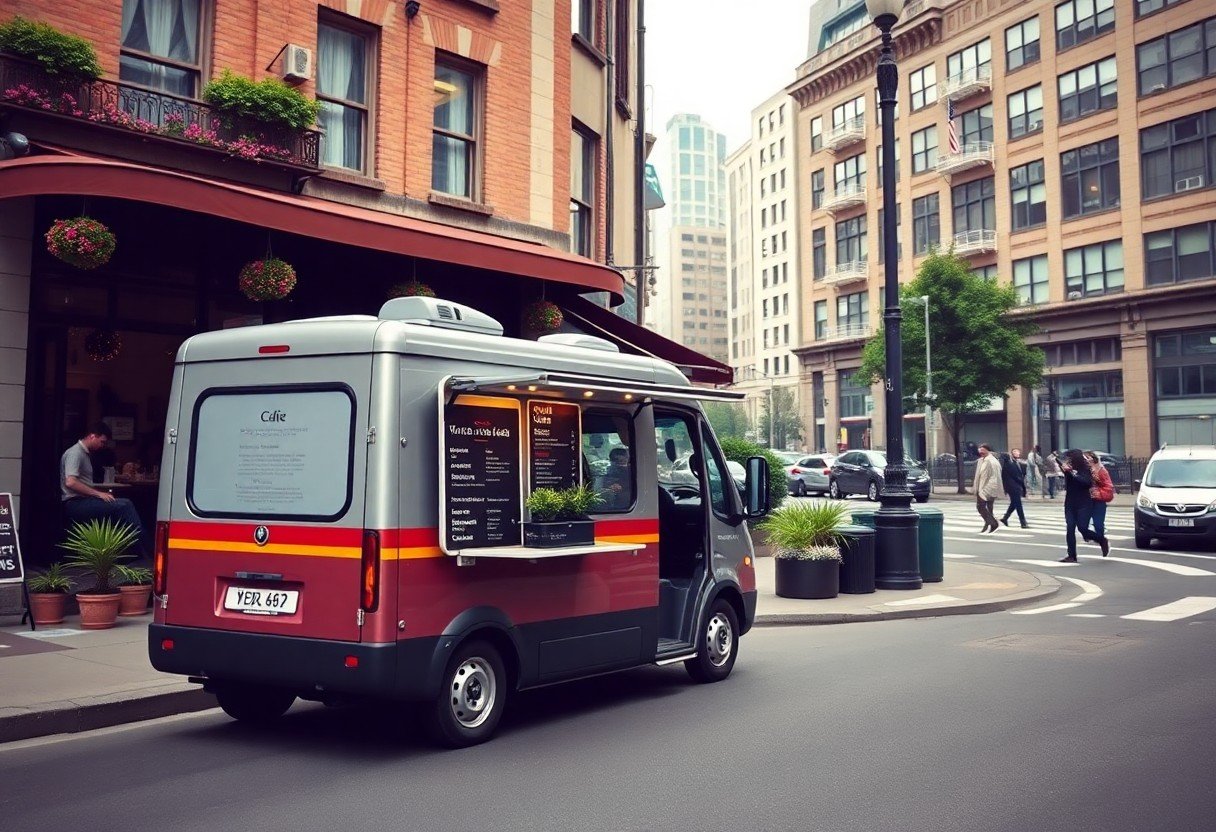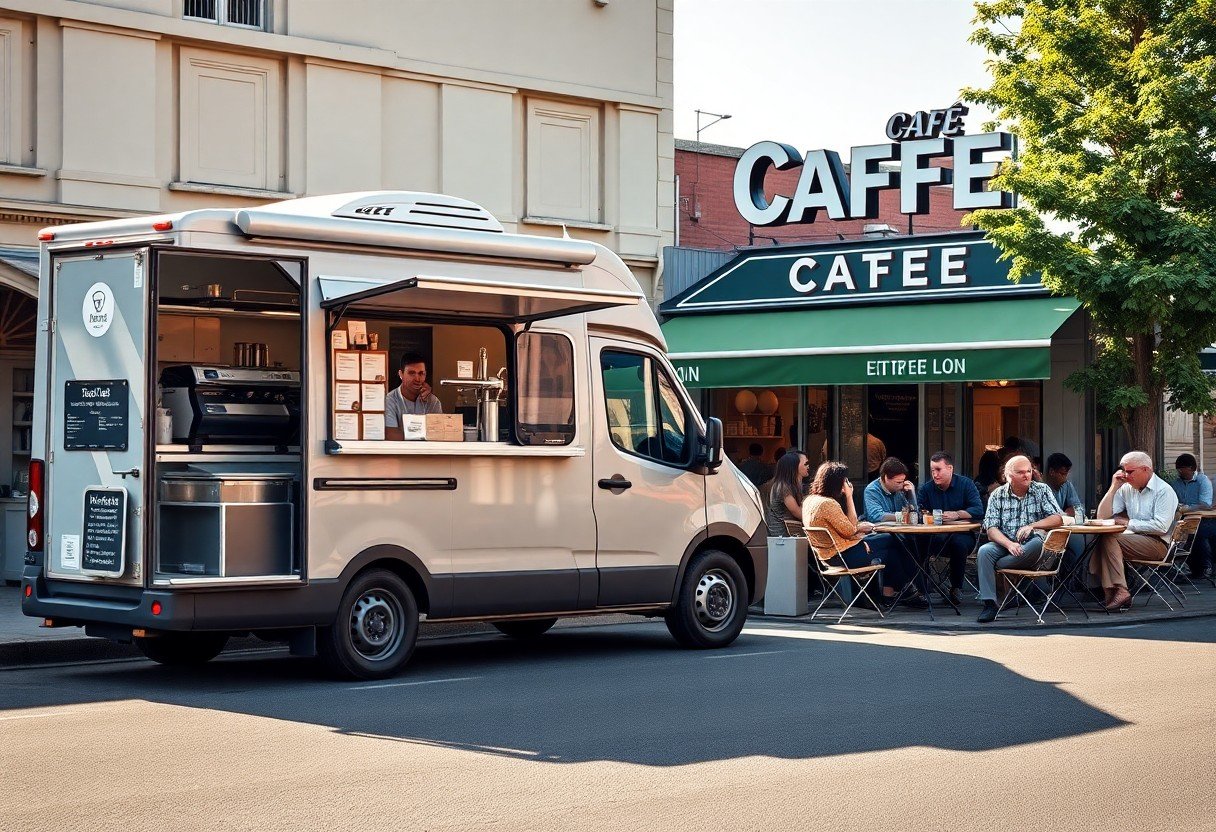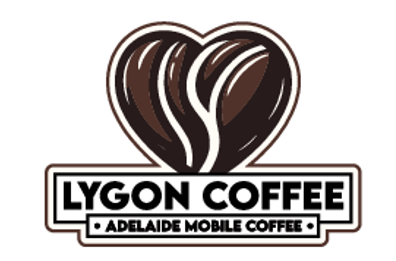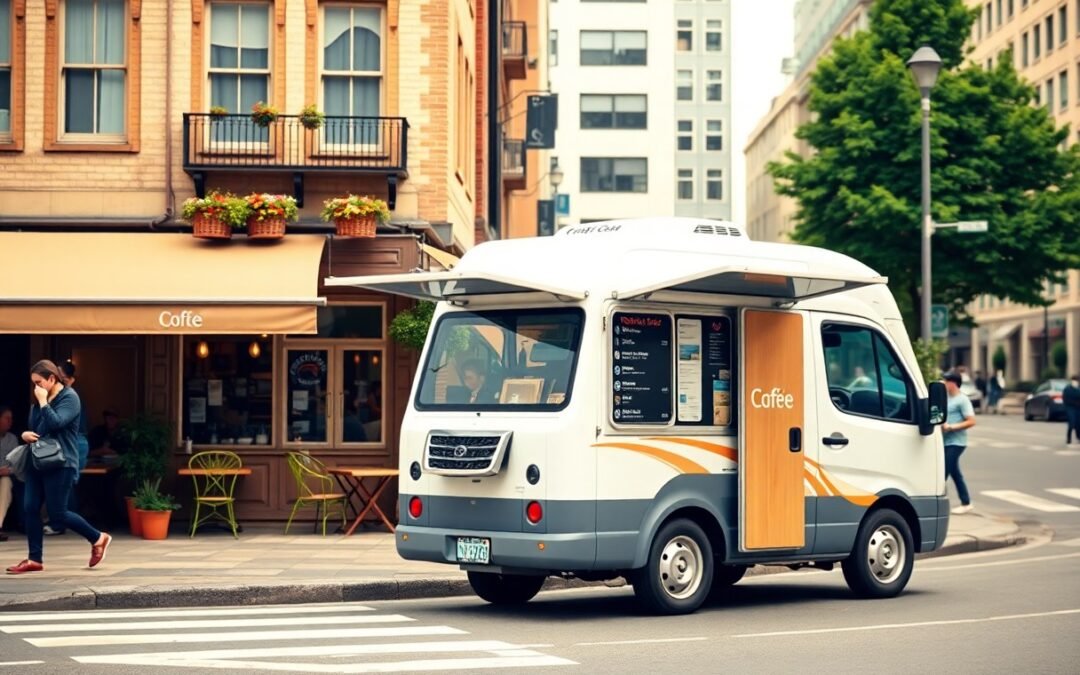There’s a growing interest in the coffee industry, prompting you to consider the ideal business model for your aspirations. The choice between a mobile coffee van and a traditional café can significantly impact your investment, operations, and customer reach. This post will explore the unique benefits and challenges of each model, helping you make an informed decision that aligns with your goals and lifestyle. Whether you seek flexibility or a fixed location, understanding these dynamics is imperative for your success in the coffee business.

Startup Costs: Crunching the Numbers
Initial Investment Breakdown
Your initial investment for a mobile coffee van is typically lower than that of a traditional café. A coffee truck can cost anywhere between $20,000 to $100,000, depending on the vehicle’s condition, equipment, and customization needs. Additionally, you may need to budget for licensing, permits, and insurance, which can add another $1,000 to $5,000 to your upfront costs. On the other hand, setting up a café demands a more substantial financial commitment, often starting around $100,000 and going upwards to half a million dollars, factoring in rent, renovations, interior furnishings, and equipment purchases. This makes the mobile model particularly accessible for new entrepreneurs looking to enter the coffee market with limited funds.
Operating costs also vary significantly. While a mobile coffee van incurs fuel and maintenance expenses, these can often be offset by the flexibility to set up in high-traffic areas. In contrast, cafés face continuous costs such as utilities and lease payments, which can inflate monthly expenses even during slow periods. Thus, assessing your available capital and financial goals is necessary to determine which model aligns more closely with your vision and resources.
Long-Term Financial Sustainability
With a mobile coffee business, your capacity for scalability is substantial. You can adapt your location based on demand, participate in events, and reach various markets without the constraints of a fixed location. This adaptability often translates into a quicker return on investment. Many operators find that once their truck is operating in the right spots, profit margins can exceed those of conventional cafés, especially when accounting for lower overhead costs.
Maintaining financial sustainability in the long run hinges on factors such as menu diversity, location strategy, and customer engagement. Continually optimizing your supply chain and managing expenses effectively can help ensure that your revenue consistently covers operational costs. Exploring options like seasonal offerings, loyalty programs, or even subscription services can further enhance profitability and keep your mobile operation thriving.
Customer Engagement: Connecting on the Go
Building a Loyal Customer Base
Your mobile coffee van can foster a loyal customer base through personalized interactions and a unique buying experience. Engaging customers on a personal level, such as remembering their names and favorite drinks, enhances loyalty and encourages repeat visits. Implementing a rewards program, such as offering a free drink after a certain number of purchases, can further incentivize customers to choose your van over other options.
Social media plays a pivotal role in building community around your brand. Regularly posting updates on your location, specials, and customer spotlights invites interaction and creates a sense of belonging. By using platforms like Instagram and Facebook to share stories and photos of satisfied customers, you can create buzz and increase foot traffic, effectively turning casual customers into loyal fans.
The Role of Location and Mobility
Your mobile coffee van’s success heavily relies on its strategic location choices. Positioning yourself near high-traffic areas such as office buildings, parks, or event venues maximizes visibility and potential sales. Having the flexibility to move your van to different locations based on real-time demand trends allows for better customer engagement and outreach, adapting to the needs of the community more effectively than a traditional café.
Seasonal events and festivals present valuable opportunities for your mobile coffee service. Setting up your van in these locations can attract large crowds who may not typically visit your standard spots. By being present at popular gatherings like farmers’ markets or community fairs, you gain access to a diverse customer base eager for a great coffee experience on the go.

Operational Flexibility: The Nimbleness Factor
Adapting to Trends and Seasons
With a mobile coffee van, you can change locations and offerings based on seasonal trends and customer preferences. For example, setting up at a local festival or farmers market allows you to tap into a larger audience while adjusting your menu to feature summer-inspired iced drinks or winter warmers. Rapid pivots in your business operations enable you to respond to new trends, such as introducing plant-based milk options as vegan diets gain popularity. Your agility in the mobile space can lead to increased profits by keeping your offerings relevant and enticing.
A café, by contrast, typically entails a fixed location that can limit its ability to shift quickly with market demands. While you can adjust your menu seasonally, the overhead costs of managing a venue may make frequent changes less viable. This can lead to missed opportunities if you fail to align with current trends or local preferences. However, using social media and targeted marketing can help you reach your existing customer base with promotional campaigns that coincide with seasonal changes.
Scalability in Both Models
Both mobile coffee vans and cafés offer unique scalability opportunities, but they navigate growth in different ways. A mobile coffee van allows you to expand rapidly by acquiring additional vans and employing new baristas. This model provides flexibility, as you can enter various markets and demographic areas with relatively low overhead. You may find it easy to test new locations and adjust based on performance metrics, optimizing your routes and hours of operation to maximize profit.
In contrast, a café’s scalability usually involves more significant financial investments, such as leasing or purchasing additional real estate or expanding your current location. If you choose to add more seating or revamp your existing space, the upfront costs can be higher compared to a mobile model. Nonetheless, a café can gain stability through establishing a loyal customer base, allowing for expansion through brand recognition and marketing, often leading to a more sustainable growth trajectory.
Scaling either model depends heavily on your business strategy and market conditions. You can leverage analytics to determine when and where to expand, whether by placement of additional vans or by opening new café locations. Furthermore, franchising or collaboration with local businesses might also present viable paths to broaden your reach effectively without overwhelming your resources.

Branding Impact: Crafting Your Identity
Visual Appeal and Customer Perception
Your brand’s visual identity significantly influences customer perceptions and attracts attention. A mobile coffee van can capitalize on eye-catching designs and vibrant colors, creating a memorable presence wherever it parks. Elements like a catchy logo, unique vehicle wrap, and appealing menu board can instantly communicate your brand’s personality and promise to customers. This distinctive visual appeal often leads to higher foot traffic and encourages social media shares, enhancing brand visibility.
In contrast, a café’s aesthetics hinge on creating an inviting atmosphere within its fixed walls. Consider factors like interior design, seating arrangements, and overall ambiance, which contribute to customer comfort and satisfaction. A well-set café that reflects your brand style can cultivate a loyal customer base, as people often return not just for the coffee but for the experience. Both models highlight the importance of visual appeal but through different mediums—your coffee van’s mobility presenting unique opportunities for on-the-go marketing.
The Importance of Community Attachment
Building a connection with your local community can immensely boost your brand’s appeal. A mobile coffee van allows you to engage directly with various neighborhoods, fostering relationships through regular visits and participation in local events. By becoming a familiar fixture at markets or festivals, you create a sense of belonging, making customers more likely to choose your brand over others. Personal interactions can lead to stronger brand loyalty, as customers feel more connected when they recognize the faces behind the business.
A café can also strengthen community attachment by hosting events, promoting local artists, and providing a space for social interactions. Establishing partnerships with nearby businesses or participating in community initiatives can enhance your visibility and reputation. Understanding the local culture and being an active participant can cultivate goodwill, encouraging patrons to support local enterprises. This community embeddedness is crucial for long-term success, as it creates a supportive network around your brand.
Regulatory Landscape: Navigating the Rules
Permits and Licensing for Each Model
Starting a mobile coffee van requires specific permits that differ significantly from those needed for a brick-and-mortar café. You must secure a food service license, which generally involves submitting an application, passing a health inspection, and sometimes obtaining a commercial driver’s license for operating the vehicle. Additionally, permits for vending may be required, depending on local regulations governing where you can park and sell food. Check with your local health department and city government to ensure you have all necessary documentation before launching your business.
On the other hand, a café often entails a more extensive licensing process that includes zoning permits, occupancy permits, and sometimes alcohol licensing if you plan to serve beverages beyond coffee. The costs associated with these permits can escalate, particularly in urban settings where regulations tend to be stricter. You’ll also need to comply with local building codes and safety regulations, which can add to the complexity and timeline of opening your café.
Compliance Challenges and Solutions
Compliance challenges emerge as you navigate the intricate landscape of health and safety regulations. Both mobile coffee vans and cafés must adhere to health codes, but mobile units face unique hurdles related to sanitation and food handling while on the move. Regular inspections by health departments ensure that you meet these standards. Develop a system for maintaining cleanliness and ensuring that all equipment is properly sanitized, as non-compliance can lead to fines or shutdowns.
Work with local regulatory agencies to understand the specific requirements for your business model. Compliance software can help in tracking important deadlines for renewals and inspections, ensuring you stay ahead of regulations. For mobile coffee vans, technology like GPS tracking can assist in adhering to city-specific parking regulations, helping avoid unwanted citations.
Investing time in research and fostering relationships with local health inspectors will facilitate smoother compliance. Regular check-ins and open communication can help preempt potential issues, allowing your business to thrive without regulatory disruptions. Attending workshops or seminars on food safety can also offer insights and best practices tailored to your business model.
Summing up
So, when deciding between a mobile coffee van and a café, consider your target audience, budget, and lifestyle preferences. A mobile coffee van offers flexibility, lower startup costs, and the ability to serve diverse locations, making it an excellent choice if you want to reach different customer bases and adapt quickly to changing market demands. In contrast, a café provides a permanent presence and the potential for a more extensive menu and customer experience, ideal for building relationships with a loyal clientele.
Your decision will ultimately depend on your business goals and personal circumstances. If you value the freedom to move and experiment with new spots, a mobile coffee van might align better with your aspirations. Alternatively, if you seek a stable foundation for long-term growth and brand recognition, investing in a café could be the right path. Assess your strengths and market opportunities to choose the model that best fits your vision.
FAQ
Q: What are the key differences between a mobile coffee van and a traditional café?
A: A mobile coffee van offers flexibility in location and lower startup costs, while a traditional café provides a fixed location with potential for a more extensive menu and built-in customer base.
Q: Which business model has lower operational costs?
A: Generally, a mobile coffee van has lower operational costs due to reduced overhead expenses like rent, utilities, and staffing compared to a traditional café.
Q: How does customer reach compare between a mobile coffee van and a café?
A: A mobile coffee van can reach a diverse range of customers by moving to different locations, whereas a café relies on foot traffic in a specific area.
Q: What are the licensing requirements for both business models?
A: A mobile coffee van typically requires permits specific to food trucks and mobile sales, while a café must obtain a business license, health permits, and inspections based on its fixed location.
Q: Which option is better for seasonal sales?
A: A mobile coffee van can adapt to seasonal demand by changing locations or participating in festivals, while a café may face challenges in attracting customers during slow seasons.

